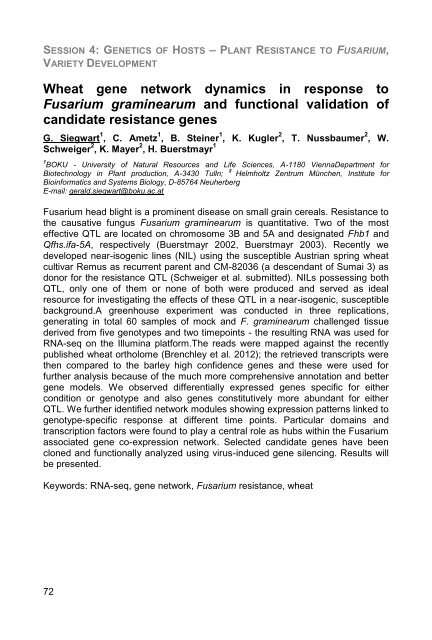EFS12- Book of abstracts - Contact
EFS12- Book of abstracts - Contact
EFS12- Book of abstracts - Contact
Create successful ePaper yourself
Turn your PDF publications into a flip-book with our unique Google optimized e-Paper software.
SESSION 4: GENETICS OF HOSTS – PLANT RESISTANCE TO FUSARIUM,<br />
VARIETY DEVELOPMENT<br />
Wheat gene network dynamics in response to<br />
Fusarium graminearum and functional validation <strong>of</strong><br />
candidate resistance genes<br />
G. Siegwart 1 , C. Ametz 1 , B. Steiner 1 , K. Kugler 2 , T. Nussbaumer 2 , W.<br />
Schweiger 2 , K. Mayer 2 , H. Buerstmayr 1<br />
1 BOKU - University <strong>of</strong> Natural Resources and Life Sciences, A-1180 ViennaDepartment for<br />
Biotechnology in Plant production, A-3430 Tulln; 2 Helmholtz Zentrum München, Institute for<br />
Bioinformatics and Systems Biology, D-85764 Neuherberg<br />
E-mail: gerald.siegwart@boku.ac.at<br />
Fusarium head blight is a prominent disease on small grain cereals. Resistance to<br />
the causative fungus Fusarium graminearum is quantitative. Two <strong>of</strong> the most<br />
effective QTL are located on chromosome 3B and 5A and designated Fhb1 and<br />
Qfhs.ifa-5A, respectively (Buerstmayr 2002, Buerstmayr 2003). Recently we<br />
developed near-isogenic lines (NIL) using the susceptible Austrian spring wheat<br />
cultivar Remus as recurrent parent and CM-82036 (a descendant <strong>of</strong> Sumai 3) as<br />
donor for the resistance QTL (Schweiger et al. submitted). NILs possessing both<br />
QTL, only one <strong>of</strong> them or none <strong>of</strong> both were produced and served as ideal<br />
resource for investigating the effects <strong>of</strong> these QTL in a near-isogenic, susceptible<br />
background.A greenhouse experiment was conducted in three replications,<br />
generating in total 60 samples <strong>of</strong> mock and F. graminearum challenged tissue<br />
derived from five genotypes and two timepoints - the resulting RNA was used for<br />
RNA-seq on the Illumina platform.The reads were mapped against the recently<br />
published wheat ortholome (Brenchley et al. 2012); the retrieved transcripts were<br />
then compared to the barley high confidence genes and these were used for<br />
further analysis because <strong>of</strong> the much more comprehensive annotation and better<br />
gene models. We observed differentially expressed genes specific for either<br />
condition or genotype and also genes constitutively more abundant for either<br />
QTL. We further identified network modules showing expression patterns linked to<br />
genotype-specific response at different time points. Particular domains and<br />
transcription factors were found to play a central role as hubs within the Fusarium<br />
associated gene co-expression network. Selected candidate genes have been<br />
cloned and functionally analyzed using virus-induced gene silencing. Results will<br />
be presented.<br />
Keywords: RNA-seq, gene network, Fusarium resistance, wheat<br />
72
















![Présentation CRB-anim [Mode de compatibilité] - Inra](https://img.yumpu.com/17418636/1/190x135/presentation-crb-anim-mode-de-compatibilite-inra.jpg?quality=85)